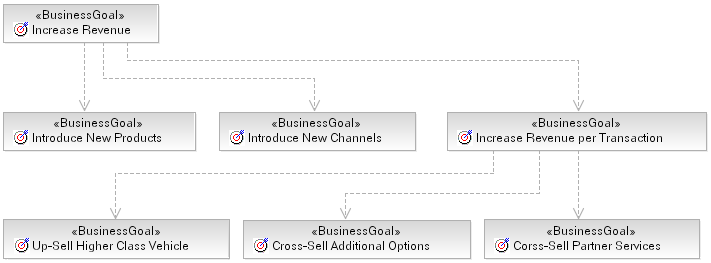Using the Artifact: Business Goals identified during the Task: Identify Business Goals and KPIs we now assign any
candidate services in the project service portfolio to the goals they support. It is also possible to identify new
candidate services where goals or sub-goals exist that have no supporting services. The method used to assign services
to goals will depend on your choice of representation for the Artifact: Service Model, and therefore the representation of the Artifact: Goal-Service Model.
During decomposition of goals into sub-goals and KPIs, the question will arise as to when we should stop this
decomposition process. As already mentioned, goal analysis can stop once sub-goals have been identified to the point at
which services that can fulfill those sub-goals can be identified. If new services are identified, update the
categorized service portfolio in the service model. For each sub-goal, identify the services needed to fulfill the
sub-goal.
Example
The table below demonstrates a completed goal-service model for an example based on a fictional car rental company
"Rent-a-Car" that is initiating a project to improve aspects of its business performance. Note that the format
Bold Italic is used to denote services where no existing or identified candidate has been
found and therefore should be added as a candidate service.
|
Goal or Sub-Goal
|
KPIs
|
Metric
|
Services
|
|
1. Increase revenue
|
Revenue increase of 20% by end of FY2005
|
Record revenue generating transactions
|
|
|
1.1. Introduce new products
|
Contribute Revenue increase of 5%
|
Record transactions for new products
|
|
|
1.2 Introduce new channels
|
Contribute revenue increase of 5%
|
Record transactions for new channels
|
|
|
1.3 Increase revenue per transaction
|
Contribute revenue increase of 7%
|
Record transactions that contain an up-sell
|
|
|
1.3.1. Up-sell higher class vehicle
|
Contribute revenue increase of 4%
|
|
-
Recommend up-sells based on customer profile
-
Determine types of Up-sell vehicles
-
Check vehicle availability
|
|
1.3.2 Cross-sell additional options
|
Contribute revenue increase of 2%
|
|
-
Purchase options individually
-
Purchase options packages
|
|
1.3.3 Cross-sell partner services
|
Contribute revenue increase of 1%
|
|
-
Reserve Hotel rooms
-
Reserve Airline tickets
-
Book destination attractions
-
Sell navigation equipment post-rental
|
This can be modeled in UML using the Business Modeling profile to capture the Goal Model as follows. Note the direction
of the dependency arrows, higher-level goals depend upon their sub-goals.

And then we can assign services to the goals they support using UML dependencies once more (decorated with the
stereotype <<supports>> for clarity).

|


